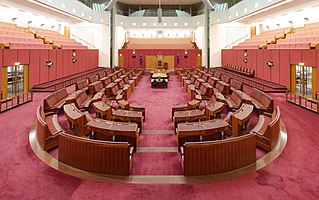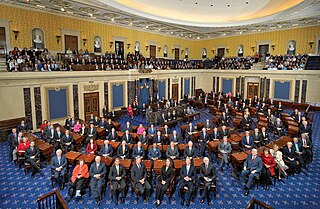
In the United States, the two major political parties, the Republicans and the Democrats, are often referred to as "the two sides of the aisle."

In the United States, the two major political parties, the Republicans and the Democrats, are often referred to as "the two sides of the aisle."
Usage of the term "aisle" comes from the United States Congress. In the Senate, desks are arranged in the chamber in a semicircular pattern and the desks are divided by a wide central aisle. By tradition, Democrats sit on the right of the center aisle (as viewed from the presiding officer's chair) while Republicans sit on the left. Unlike in the Senate, there are no assigned desks in the House of Representatives chamber, but as in the Senate, Democrats sit on the right of the center aisle (as viewed from the presiding officer's chair) while Republicans sit on the left. [1]
A member of one party who votes for legislation supported by the other party and generally opposed by his own party is described as "crossing the aisle" (a similar phrase used in countries operating under the Westminster system, is "crossing the floor").
A (proposed) law that has bipartisan support is said to be supported by both sides of the aisle.

The speaker of the United States House of Representatives, commonly known as the speaker of the House, is the presiding officer of the United States House of Representatives. The office was established in 1789 by Article I, Section 2 of the U.S. Constitution. The speaker is the political and parliamentary leader of the House of Representatives and is simultaneously the House's presiding officer, de facto leader of the body's majority party, and the institution's administrative head. Speakers also perform various other administrative and procedural functions. Given these several roles and responsibilities, the speaker usually does not personally preside over debates. That duty is instead delegated to members of the House from the majority party. Neither does the speaker regularly participate in floor debates.

The positions of majority leader and minority leader are held by two United States senators and members of the party leadership of the United States Senate. They serve as the chief spokespersons for their respective political parties holding the majority and the minority in the United States Senate. They are each elected as majority leader and minority leader by the senators of their party caucuses: the Senate Democratic Caucus and the Senate Republican Conference.

James Merrill Jeffords was an American lawyer and politician who served as a U.S. senator from Vermont. Sworn into the Senate in 1989, he served as a Republican until 2001, when he left the party to become an independent and began caucusing with the Democrats. Jeffords retired from the Senate in 2007. Prior to serving in the Senate, he served as the U.S. representative for Vermont's at-large congressional district from 1975 to 1989.

In parliamentary systems, politicians are said to cross the floor if they formally change their affiliation to a second party after being elected as a member of a first party, or voting against the approved party lines.

The California State Assembly is the lower house of the California State Legislature, the upper house being the California State Senate. The Assembly convenes, along with the State Senate, at the California State Capitol in Sacramento.

The California State Senate is the upper house of the California State Legislature, the lower house being the California State Assembly. The State Senate convenes, along with the State Assembly, at the California State Capitol in Sacramento.

The Maryland Senate, sometimes referred to as the Maryland State Senate, is the upper house of the General Assembly, the state legislature of the U.S. state of Maryland. Composed of 47 senators elected from an equal number of constituent single-member districts, the Senate is responsible, along with the Maryland House of Delegates, for passage of laws in Maryland, and for confirming executive appointments made by the Governor of Maryland.
In the United States Senate, the nuclear option is a parliamentary procedure that allows the Senate to override a standing rule by a simple majority, rather than the two-thirds supermajority normally required to amend Senate rules.
Party switching is any change in political party affiliation of a partisan public figure, usually one currently holding elected office.

The New Hampshire House of Representatives is the lower house in the New Hampshire General Court, the bicameral legislature of the state of New Hampshire. The House of Representatives consists of 400 members coming from 204 legislative districts across the state, created from divisions of the state's counties. On average, each legislator represents about 3,300 residents.
The Standing Rules of the Senate are the parliamentary procedures adopted by the United States Senate that govern its procedure. The Senate's power to establish rules derives from Article One, Section 5 of the United States Constitution: "Each House may determine the rules of its proceedings ..."
A congressional caucus is a group of members of the United States Congress that meet to pursue common legislative objectives. Formally, caucuses are formed as congressional member organizations (CMOs) through the United States House of Representatives and the United States Senate and governed under the rules of these chambers. In addition to the term "caucus", they are sometimes called conferences, coalitions, study groups, task forces, or working groups. Many other countries use the term parliamentary group; the Parliament of the United Kingdom has many all-party parliamentary groups.

The Nevada Assembly is the lower house of the Nevada Legislature, the state legislature of the U.S. state of Nevada, the upper house being the Nevada Senate. The body consists of 42 members, elected to two-year terms from single-member districts. Each district contained approximately 64,299 people as of the 2010 United States Census. Term limits, limiting assembly members to six 2-year terms, took effect in 2010. Twelve members of the Nevada Assembly were termed out with the 2010 election serving their last legislative session in 2011.

The Louisiana State Senate is the upper house of the state legislature of Louisiana. All senators serve four-year terms and are assigned to multiple committees.

The candy desk has been a tradition of the United States Senate since 1968, whereby a senator who sits at a particular desk near a busy entrance keeps a drawer full of candy for members of the body. The current occupant of the candy desk is Pennsylvania Senator Pat Toomey.

The Old Senate Chamber is a room in the United States Capitol that was the legislative chamber of the United States Senate from 1810 to 1859 and served as the Supreme Court chamber from 1860 until 1935. It was designed in Neoclassical style and is elaborately decorated. In 1976 as part of the United States Bicentennial celebrations, it was restored to the appearance of when it served the Senate in the 1850s; it is preserved as a museum and for the Senate's use.

The United States House of Representatives, usually referred to as the House, is the lower house of the United States Congress, with the Senate being the upper house. Together they compose the national bicameral legislature of the United States.

The United States Senate is the upper chamber of the United States Congress, with the House of Representatives being the lower chamber. Together they compose the national bicameral legislature of the United States.
A filibuster is a tactic used by a minority group of members of the U.S. Senate who oppose and prevent the passage of a bill, despite the bill having enough supporters to pass it. The tactic involves taking advantage of the rule that 60 votes are needed to stop debate on a bill. Debate on a bill can last indefinitely and must conclude before the bill can be voted on and passed. Therefore, an opposing minority of at least 41 members can prevent the passage of a bill, even if a supporting majority of at least 51 members could later pass it.

The United States Senate Chamber is a room in the north wing of the United States Capitol that has served as the legislative chamber of the United States Senate, since January 4, 1859. The Senate first convened in its current meeting place after utilizing Federal Hall, Congress Hall, and the Old Senate Chamber in the Capitol building for the same purpose.